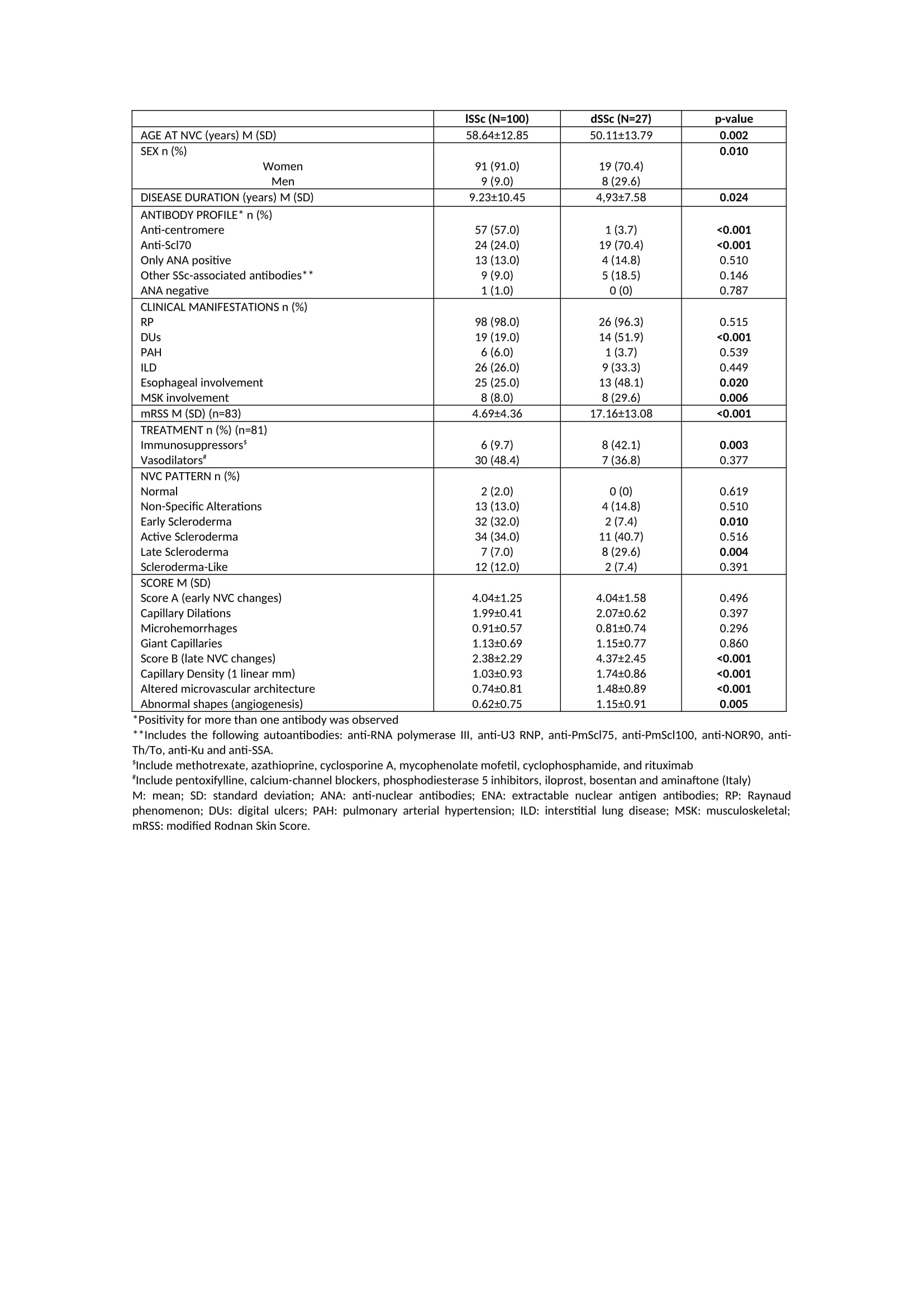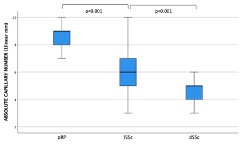Session Information
Session Type: Poster Session C
Session Time: 10:30AM-12:30PM
Background/Purpose: Systemic sclerosis (SSc) is a connective tissue disease characterized by microvascular damage, immune system activation and fibrosis. Clinical phenotypes are defined according to skin fibrosis – limited (lSSc) and diffuse (dSSc) SSc. Few studies suggested a higher prevalence of “late” scleroderma pattern (LSP) and capillary loss on nailfold videocapillaroscopy (NVC) in dSSc1-3. However, the association of the detailed NVC findings and the extent of skin fibrosis is not yet clearly stablished.
The aim of this study was to compare the NVC findings between lSSc and dSSc patients (pts).
Methods: We enrolled 157 pts at the Division of Rheumatology of the University of Genova; 127 SSc pts and 30 primary Raynaud phenomenon (pRP) pts. The NVC patterns and the absolute number of capillaries (1 linear mm) of the first NVC performed were accessed. The scores A (early NVC changes: capillary dilations, microhemorrhages and giant capillaries) and B (advanced NVC changes: capillary density, altered microvascular architecture and abnormal capillary shapes (angiogenesis)) were also calculated in the NVC of SSc pts. These scores represent semiquantitative assessments ranking from 0 to 3 according to the extent of NVC parameters (0: no changes; 1: ≤33% changes; 2: 33-66% changes; 3: ≥66% changes)4.
Results: The absolute number of capillaries showed a statistically significant difference between pts with pRP, lSSc and dSSc (F(2,154)=50.18,p< 0.001) (Image1). The post-hoc analysis demonstrated that the absolute capillary number was significantly higher in pRP pts (8.87±0.78,p< 0.001) than in SSc pts; although capillary loss was present in both lSSc and dSSc, it was significantly higher in pts with dSSc (4.89±1.53,p< 0.001) compared to lSSc (6.18±1.75,p< 0.001). Additionally, a significantly higher B score was observed in dSSc (t(125)=-3.95,p< 0.001), with a lower capillary density (H(1)=12.01,p< 0.001), altered capillary architecture (H(1)=13.96,p< 0.001) and presence of abnormal shapes (angiogenesis) (H(1)=8.00,p=0.005) (Table1). Furthermore, statistically significant associations were established between LSP and dSSc (c2(1,126)=10.45,p=0.004), as well as between “early” scleroderma pattern (ESP) and lSSc (c2(1,126)=6.56,p=0.010). No association was found regarding A score and the extent of skin fibrosis in SSc.
Conclusion: Present study highlights the importance of NVC in distinguishing microvascular damage between lSSc and dSSc. Both clinical phenotypes are associated with capillary loss, particularly in dSSc, despite the greater use of immunosuppressants. Moreover, higher B scores seem correlated with dSSc and both capillary density and abnormal shapes (angiogenesis). This finding was confirmed by the association of LSP with dSSc. No differences regarding giants were found between lSSc and dSSc. This can be explained by the prevalence of ESP (presence of few giants) in lSSc and of LSP (absence of giants) in dSSc.
REFERENCES:
1Cutolo M et al. Nat Rev Rheumatol 2021
2Ingegnoli F et al. Microvasc Res. 2013
3Sato LT et al. Acta Reumatol Port. 2009
4Sulli A et al. Ann Rheum Dis 2008
To cite this abstract in AMA style:
Correia A, Campitiello R, Gotelli E, Pizzorni C, Sulli A, smith v, Cutolo M. Nailfold Videocapillaroscopy Findings in Patients with Limited Cutaneous versus Diffuse Cutaneous Systemic Sclerosis: The First Detailed Retrospective Study [abstract]. Arthritis Rheumatol. 2024; 76 (suppl 9). https://acrabstracts.org/abstract/nailfold-videocapillaroscopy-findings-in-patients-with-limited-cutaneous-versus-diffuse-cutaneous-systemic-sclerosis-the-first-detailed-retrospective-study/. Accessed .« Back to ACR Convergence 2024
ACR Meeting Abstracts - https://acrabstracts.org/abstract/nailfold-videocapillaroscopy-findings-in-patients-with-limited-cutaneous-versus-diffuse-cutaneous-systemic-sclerosis-the-first-detailed-retrospective-study/


